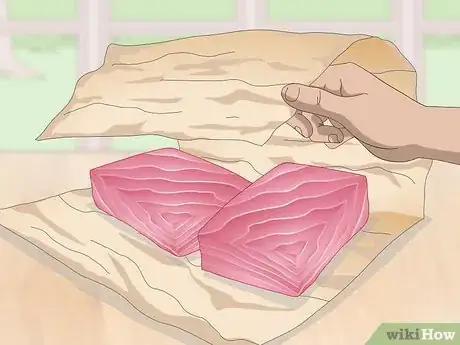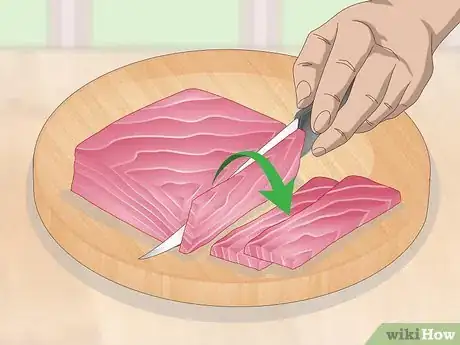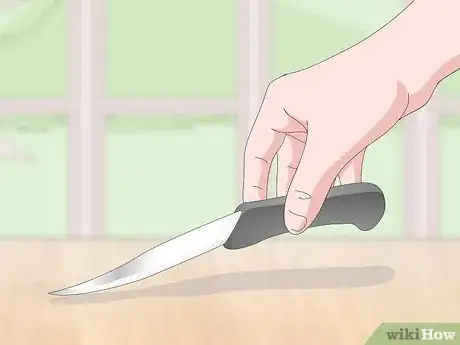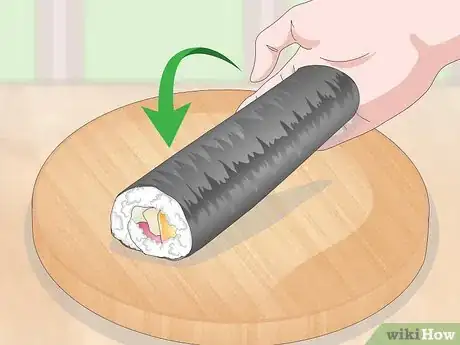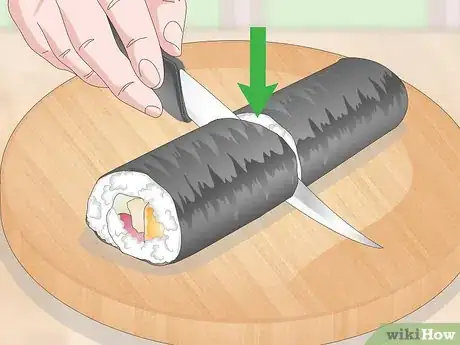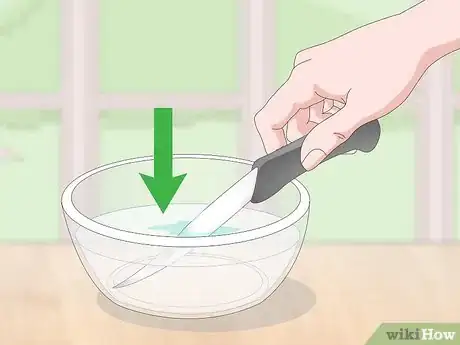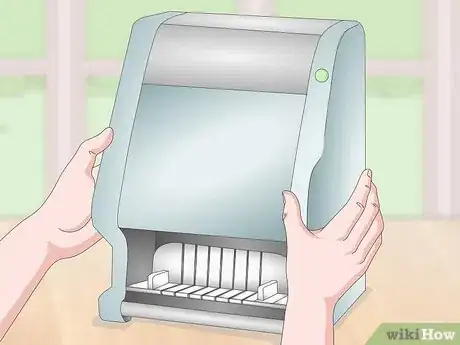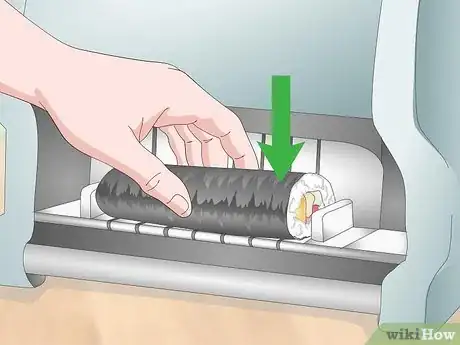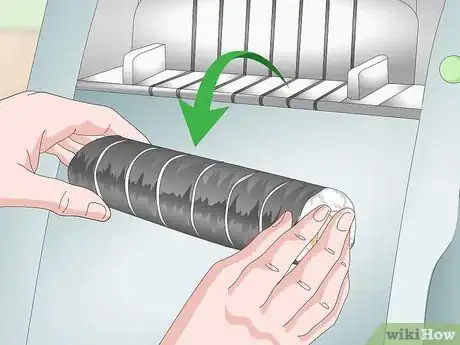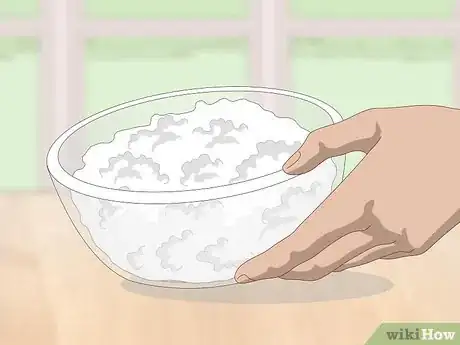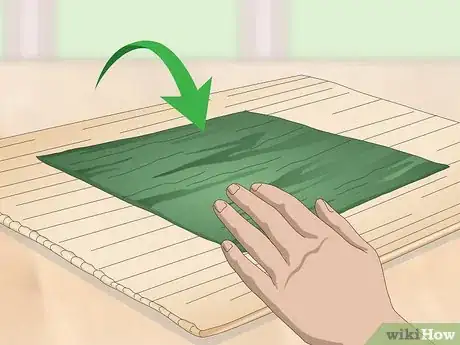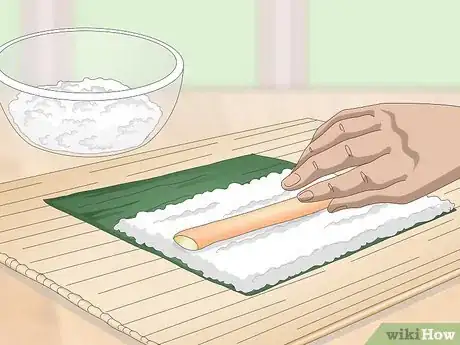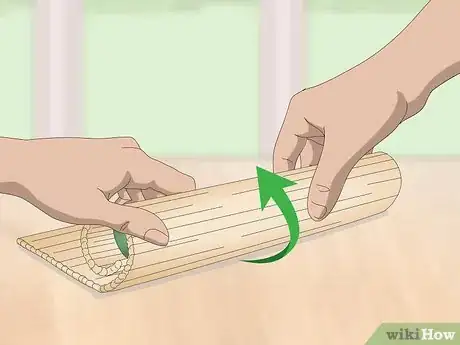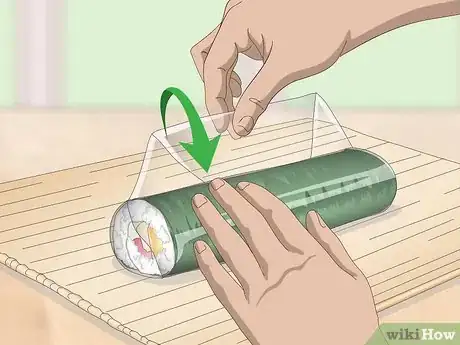This article was co-authored by Daniel Siriban. Daniel Siriban is a Japanese Personal Chef and the Owner of Roshi Experience. With over 18 years of culinary experience, he specializes in sushi, teppanyaki, and traditional Japanese dining. Daniel holds an AA in Restaurant, Culinary, and Catering Management from The Art Institute of California, Orange County.
There are 15 references cited in this article, which can be found at the bottom of the page.
This article has been viewed 27,079 times.
Making sushi involves both cutting the fish and the roll itself. The fish needs to be thinly sliced into long strips before you make the sushi roll. Cutting the sushi roll can be tricky because it’s easy for the roll to get crushed, or for the ingredients to be pushed out of place. You can slice sushi rolls using either a very sharp fish knife, or using a speciality cutting machine. Using the right technique with either method will have you slicing perfect sushi rounds in no time.
Steps
Cutting the Fish
-
1Purchase fish that is sold specifically for sushi. Check that the fish is bright and not dull, to make sure that it's fresh. Yellowfin tuna or salmon are common types of fish to use in sushi rolls.[1]
- Many supermarkets and fish suppliers sell fish especially for sushi. This will make the preparation easier.
- Sushi fish is sold in a block shape and already has the skin removed.
-
2Use the fish straight away if it’s fresh. Place the fish in the refrigerator as soon as you arrive home. Use it on the same day that you purchased it.[2]
- If the fish is frozen, keep it in a freezer until you’re ready to use it. Make sure that it thaws properly first.
Advertisement -
3Slice the fish into thin strips that are parallel to the long edge.[3] When the block is fish is in front of you, you will see diagonal grains of connective tissue. Use a sharp fish knife to slice the block into strips, which will make the connective tissue run at a 30-45 degree angle.[4]
- Cutting the connective tissue at an angle makes the fish easier to chew.
Using a Knife or Roll Cutter
-
1Get a fish knife with a sharp blade if you want to cut sushi with a knife. Fish knives that have long, slim, and very sharp blades are the best for cutting sushi. These can be purchased online or from homeware stores.[5]
- If you are putting fish in your sushi, then you can use the same knife to slice the fish and the roll.
- Only very sharp knives can cut sushi rolls efficiently.[6] Using a knife that isn’t sharp means that you will need to use a sawing motion to cut through the roll, which will damage and crush the ingredients.[7]
-
2Place 1 sushi roll on a wooden chopping board. You need a flat and sturdy surface to cut the sushi roll on. Make sure that the chopping board is large enough to comfortably fit the full roll.[8]
- Chopping boards that aren’t wooden will dull your knife very fast.
-
3Slice the sushi roll in half. Estimate the center of the roll and slice cleanly through it using the sharp fish knife. Make sure that you have sliced to the very bottom edge of the roll.[9]
- Provided that your knife is extremely sharp, it should only take one slice to divide the roll down the middle.[10]
-
4
-
5
-
6Purchase a sushi roll cutter if you make large quantities of sushi. You can purchase these online or from specialised homeware stores. Sushi roll cutters come in different sizes, depending on how many sushi rolls you want to cut at once.
- Sushi roll cutters are tabletop devices that can be set up on your kitchen counter. These use a power source to take an entire roll of sushi and slice it precisely into sections.
- Sushi roll cutters can be small and gadget sized, which are ideal if you make small quantities of sushi. These devices are also available in larger catering sizes, which can slice multiple rolls at one time.
- Make sure that you place the sushi roll cutter close to a power source so that the cord can reach. Also, ensure that it is away from any water that may splash as this is dangerous for electrical appliances.
-
7Place the sushi rolls on the cutting tray. Make sure they sit flat on the tray and that the entire roll can fit. The grooves on the tray indicate where the cuts will be made.[18]
- If the instructions for your machine say that you can load multiple rolls at once, then stack these onto the tray accordingly.
- Most smaller machines only slice 1 roll at a time, but larger machines can usually slice 4 at once.
- Keep your hands far away from any blades if these are exposed in your machine.
-
8Start the sushi roll cutter by pulling the lever or pressing the button. Make sure that the machine is switched on and plugged into an electrical socket, first. Starting the sushi roll cutter will be specific to your machine, so be sure to read the instructions. [19]
- This will begin the cutting process. It will only take a few seconds for the sushi rolls to be sliced!
- The cutting tray will automatically be drawn through the blades when the machine starts.
-
9Remove the cut sushi rolls from the cutting machine. After the lid has lifted up, take the rolls out of the machine. Lift the roll out with both hands supporting it.[20]
- The sushi will still be in a roll formation as the rice will hold it together, however the pieces can break apart easily.
Making Tightly-Wrapped Sushi
-
1Use sushi rice to make the sushi. Sushi rice is short-grain and sticky, which is necessary for holding the roll together. Other rice varieties such as white, brown, long-grain, jasmine, or basmati rice won’t substitute well, and the roll will be more likely to fall apart.[21]
- Using a variety of rice that isn’t sushi rice will also mean that it won’t taste as good.
- Trying to cut through a sushi roll that isn’t made with the correct rice means that it will be easier for the roll to unwrap, and for the ingredients will fall out as you try to slice through it.
-
2
-
3Place a thin layer of ingredients over the bottom ¾ of the nori. Use a small handful or sushi rice to spread over this space. Add a thin layer of vegetables and/or fish over the bottom ⅓ of the rice.[27]
- Be careful not to overfill the roll, otherwise it won’t hold together well.
- The empty section of nori is where the roll will seal together.
-
4Roll the sushi firmly so that the roll is tight and stays together. When it comes to rolling the sushi, make sure that it is as wrapped as tightly together as possible, and that the edge is firmly stuck down. When you have formed a roll, gently squeeze it so that it sticks together.[28]
- A roll that isn’t held together tightly will be more likely to fall apart when it comes to slicing it.
-
5Cover the roll in plastic wrap once it’s rolled. When you have formed the sushi roll, place it on a piece of plastic wrap. Use the plastic wrap to tightly wrap the entire roll, making sure that both ends are tightly covered. This will help the roll to stick together.[29]
- You can also slice through the sushi while it’s wrapped in plastic to keep it held together.
Warnings
- Always consume sushi that contains raw fish within 24 hours, as it can very quickly become susceptible to bacteria.[30]⧼thumbs_response⧽
References
- ↑ https://www.seriouseats.com/2010/07/sushi-week-part-2-how-to-make-makizushi-sushi-rolls.html
- ↑ https://www.seriouseats.com/2010/07/sushi-week-part-2-how-to-make-makizushi-sushi-rolls.html
- ↑ Daniel Siriban. Japanese Personal Chef. Expert Interview. 1 September 2021.
- ↑ https://www.seriouseats.com/2010/07/sushi-week-part-2-how-to-make-makizushi-sushi-rolls.html
- ↑ https://www.denverpost.com/2012/06/25/sushi-for-beginners-five-steps-to-making-sushi-at-home/
- ↑ Daniel Siriban. Japanese Personal Chef. Expert Interview. 1 September 2021.
- ↑ Daniel Siriban. Japanese Personal Chef. Expert Interview. 1 September 2021.
- ↑ http://kitchenknifeguru.com/cutting-boards/cutting-boards-wood-and-plastic/
- ↑ https://www.denverpost.com/2012/06/25/sushi-for-beginners-five-steps-to-making-sushi-at-home/
- ↑ Daniel Siriban. Japanese Personal Chef. Expert Interview. 1 September 2021.
- ↑ Daniel Siriban. Japanese Personal Chef. Expert Interview. 1 September 2021.
- ↑ https://www.sushifaq.com/howtomakesushiathome/tips-for-making-perfect-sushi/
- ↑ Daniel Siriban. Japanese Personal Chef. Expert Interview. 1 September 2021.
- ↑ https://www.goodhousekeeping.co.uk/institute/cookery-videos/rice-grains-and-pulses/how-to-make-sushi
- ↑ Daniel Siriban. Japanese Personal Chef. Expert Interview. 1 September 2021.
- ↑ https://www.geniuskitchen.com/recipe/how-to-make-and-roll-sushi-261193
- ↑ https://www.sushifaq.com/howtomakesushiathome/tips-for-making-perfect-sushi/
- ↑ https://youtu.be/8IzEdvAjCaU?t=54
- ↑ https://youtu.be/8IzEdvAjCaU?t=66
- ↑ https://youtu.be/8IzEdvAjCaU?t=74
- ↑ http://justhungry.com/japanese-basics-plain-rice-sushi-rice
- ↑ Daniel Siriban. Japanese Personal Chef. Expert Interview. 1 September 2021.
- ↑ https://makemysushi.com/How-to-make-sushi/maki-roll
- ↑ Daniel Siriban. Japanese Personal Chef. Expert Interview. 1 September 2021.
- ↑ https://thepioneerwoman.com/cooking/sushi-101-how-to-make-sushi-rolls/
- ↑ https://thepioneerwoman.com/cooking/sushi-101-how-to-make-sushi-rolls/
- ↑ https://www.denverpost.com/2012/06/25/sushi-for-beginners-five-steps-to-making-sushi-at-home/
- ↑ https://www.geniuskitchen.com/recipe/how-to-make-and-roll-sushi-261193
- ↑ http://www.slapyodaddybbq.com/2014/04/slapilicious-bbq-pulled-pork-sushi-roll/
- ↑ https://makemysushi.com/Sushi-Essentials/long-sushi-last-food-safety-guidelines
